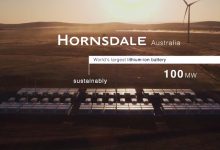The Tesla big battery in South Australia continues to deliver excellent results for owner Neoen, and the French-based company wants to explore more battery storage investments.
The battery, officially known as the Hornsdale Power Reserve and brought into operation in December 2017, lifted its revenues by 20 per cent in the first three months of 2019 to €4.2 million ($A6.8 million), as a result of stronger frequency control and arbitrage markets.
The battery has a fixed contract with the South Australia government to provide emergency grid services, and gets paid around $4 million a year for that. But the battery makes most of its money from the frequency control market and by buying and selling electricity (arbitrage) on the spot market.
The battery delivered total revenues of $29 million in 2018, and profits of $22 million, a healthy operating margin of around 75 per cent. If that margin continues in the first quarter, and data from the Australian Energy Market Operator suggests it likely did, then operating profits could have been around $5 million for the first quarter.
“In view of HPR’s operating and financial performance, the group is actively continuing with its efforts to develop new capacity in the markets in which it operates,” the company said in a statement on Tuesday (France time).
Neoen is currently building a 20MW/34MWh battery – again using Tesla technology – at the Bulgana renewable energy hub in Victoria, primarily to support a neighbouring wind farm and deliver 100 per cent renewable energy to what will be the country’s largest vegetable greenhouse, operated by Nectar Farms.
It also owns a small 6MW/6MWh battery in France.
Despite the development of new battery installations in Australia – at Dalrymple North in South Australia, and at Gannawarra and Ballarat in Victoria, and new installations being completed at Lake Bonney and Lincoln Gap in South Australia, and the Kennedy energy park in Queensland – the storage market remains largely undeveloped.
“We are still quite bullish for Australia,” Neoen chairman Xavier Barbara told investors in a recent call. “That is true for wind, it is true for solar, and it is especially true for storage …. we are well positioned. We will have more good years in Australia in storage.”
 AEMO data reveals that batteries – due to their greater flexibility and speed of response – appear better positioned to make money out of arbitrage in Australian markets than bigger pumped hydro plants, and have also grabbed a significant share of the frequency and ancillary services market.
AEMO data reveals that batteries – due to their greater flexibility and speed of response – appear better positioned to make money out of arbitrage in Australian markets than bigger pumped hydro plants, and have also grabbed a significant share of the frequency and ancillary services market.
Neoen’s overall revenues for the quarter were boosted by a big jump in solar, where revenues more than doubled to €26 million largely from new plants such as the 150MW Coleambally project in NSW that was not complete at the same time last year.
Wind power remains Neoen’s biggest contributor by revenue, which grew slightly to €28.9 million, reflecting an increase in capacity but also the switch for assets such as Hornsdale wind farms in South Australia from spot market to contracted power purchase agreements. (Hornsdale has 20-year fixed price deals with the ACT government at various prices as part of its commitment to 100 per cent renewable energy by 2020).
“This reflects the Group’s ability to develop and operate intrinsically competitive assets (at “grid parity”) and to allow its long-term clients to benefit from this, while opportunistically securing additional revenues during the initial months of operation of these facilities,” the company said.
Neoen sources just over half its revenues from Australia. It is also active in Mexico, where it is building a 375MW major solar plant at AquasCalientes with a contract price of less than $US19/MWh, one of the lowest in the world.










